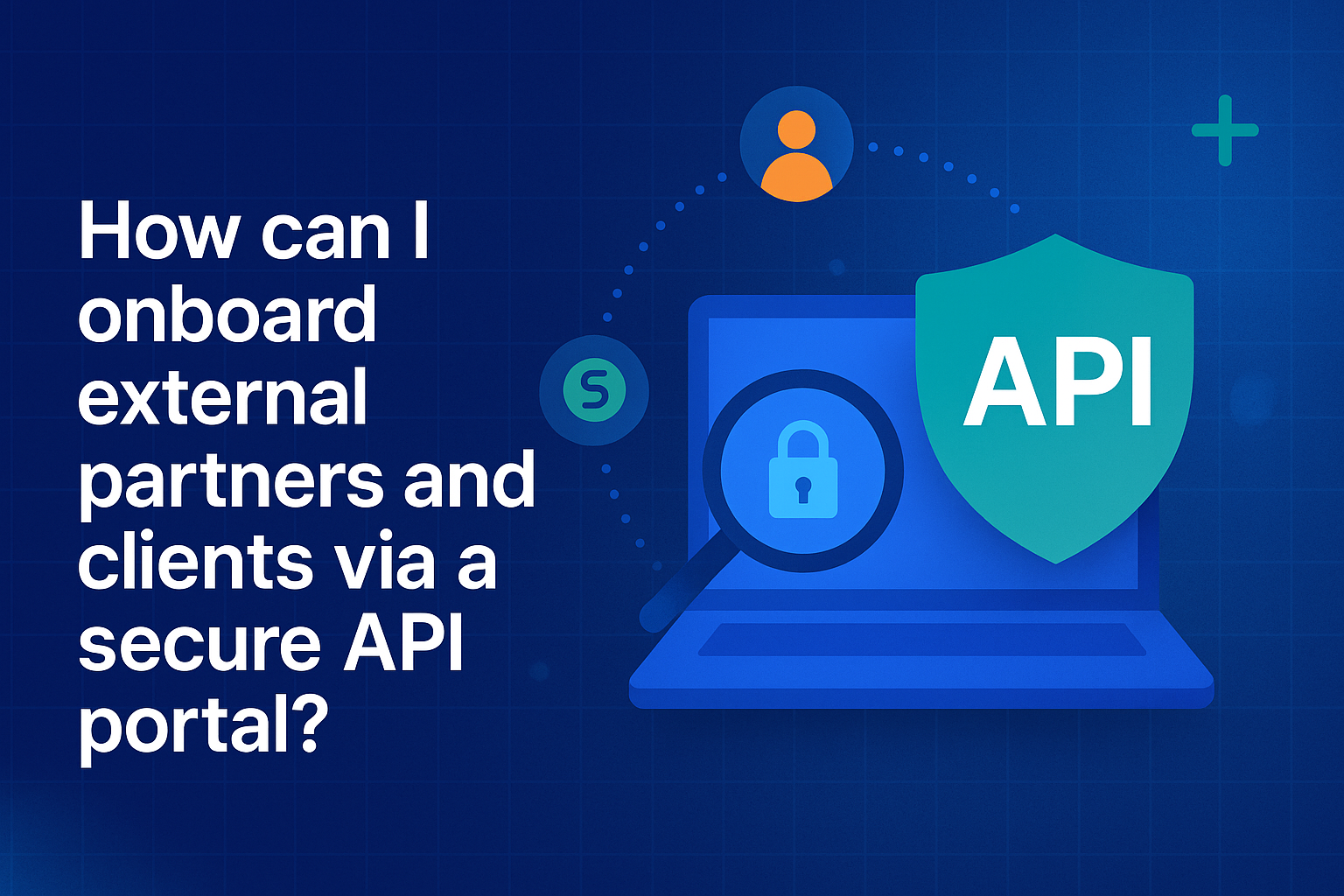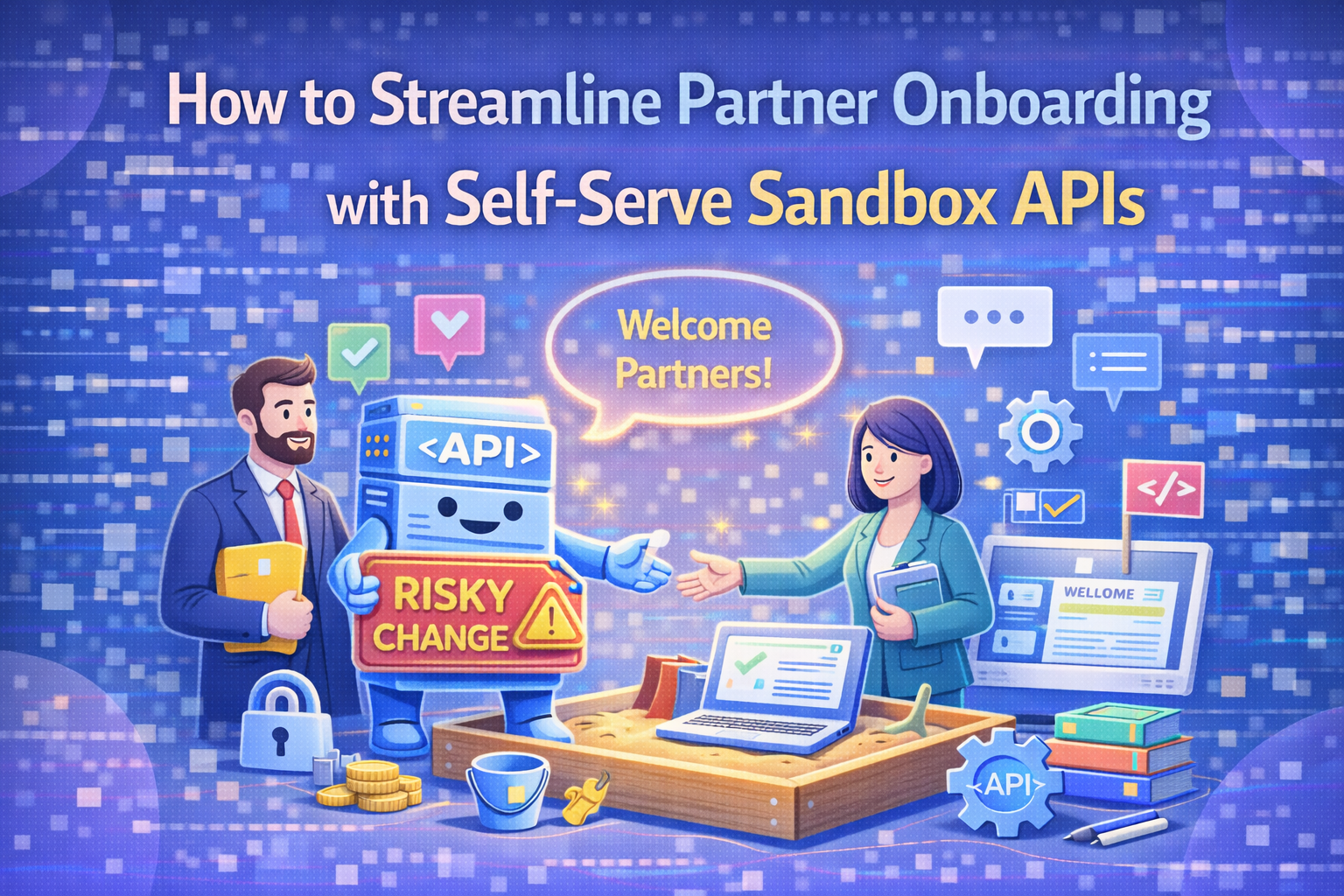Blog
How can I onboard external partners and clients via a secure API portal?
Updated on:

Partner onboarding often stalls not due to tech gaps, but trust gaps, who’s accessing what, and how securely? A modern API portal fixes this by combining identity, sandboxing, approvals, and observability into one governed flow, turning onboarding from a risk into a growth enabler.
DigitalAPI.ai makes this seamless. Its secure developer portal unifies SSO, OAuth2, sandbox testing, policy enforcement, and real-time analytics, backed by Flylytics and API-GPT assistance. Partners onboard faster, compliance stays intact, and enterprises scale collaborations without sacrificing control.
Streamline partner onboarding with DigitalAPI's developer portal today. Book a Demo!
Every enterprise wants to move fast with partners, but partner onboarding is where speed usually dies. APIs are ready, documentation exists, yet onboarding an external client can still take weeks. Why? Because the friction isn’t technical. it’s trust. Who’s accessing what data? Which gateway enforces the policy? How do you expose APIs safely without opening the floodgates? That’s where a secure API portal changes the equation.
It’s not just a documentation site; it’s your governed entryway for external collaboration, auth, sandbox, approval, audit, everything in one flow. In this blog, we’ll unpack how a modern API portal can help onboard partners securely at scale, so your next external integration doesn’t feel like a security exception, but a growth channel.
What “secure partner onboarding” really means (and common pitfalls)
Secure partner onboarding is the discipline of enabling external organizations, partners, vendors, and clients to integrate with your APIs while maintaining data integrity, compliance, and control. It’s more than provisioning credentials; it’s about designing a governed pathway that makes collaboration seamless yet accountable.
At its core, secure onboarding ensures that every external developer is verified, every API call is policy-enforced, and every interaction is auditable. This means setting up role-based access, enforcing authentication standards (OAuth2, SSO, or API keys), providing sandbox environments for safe testing, and establishing usage contracts that define quotas and SLAs. Done right, it balances two forces that usually conflict, speed and security, giving partners self-serve access while enterprises retain oversight.
Here are some common pitfalls:
- Shared or static credentials without identity verification
- Manual approval flows that delay go-live
- Inconsistent documentation and unclear onboarding steps
- Lack of a sandbox or testing environment
- No unified visibility across gateways or partner APIs
- Missing audit trails for compliance and forensic review
.png)
The 7 building blocks of a secure API portal for external partners
A secure API portal isn’t just a front-end for documentation; it’s the command center of your partner ecosystem. Each layer must work together to balance developer autonomy with enterprise-grade control. Here are the seven foundational pillars that make external onboarding fast, safe, and scalable.
1. Identity and access management (IAM)
Every secure onboarding starts with identity. Your portal should integrate with SSO, OAuth2, or OpenID Connect to verify who’s accessing what, and enforce role-based or attribute-based access control (RBAC/ABAC). This ensures each partner sees only the APIs, environments, and data they’re entitled to, no more, no less. Strong IAM prevents credential sprawl and enables centralized offboarding when relationships end.
2. Approval workflows and governance
Partners shouldn’t go live with a production API just because they registered. A secure portal enables tiered approval workflows, automatically granting sandbox access while routing production access through policy checks or human review. This keeps security, legal, and compliance teams in sync without slowing down developers.
3. Sandbox environments for safe experimentation
Before partners touch real data, they should be able to test APIs in a controlled sandbox with mock payloads and rate limits. A sandbox reduces risk while improving developer experience, allowing partners to validate integrations early. It also minimizes production errors and support overhead once the partnership goes live.
4. Rich, interactive documentation
Documentation is the most underestimated security control. Clear, accurate, and interactive API documentation reduces misuse and guesswork. Your portal should offer auto-generated docs from OpenAPI specs, SDKs in multiple languages, and “Try It” consoles that simulate real requests securely. Good documentation is how you turn secure APIs into usable ones.
5. Policy enforcement and quotas
Security isn’t static; it’s enforced continuously through rate limiting, throttling, and quota management. The portal should integrate with your gateway policies to apply these rules per partner, per plan, or per environment. Dynamic policy enforcement keeps bad actors and accidental overuse in check without blocking legitimate usage.
6. Observability and audit trails
Once APIs go live, visibility is your safety net. A secure portal must provide real-time metrics, usage, latency, error rates, alongside immutable audit logs. This helps teams detect anomalies, trace activities back to specific partners, and demonstrate compliance during audits. Transparency builds trust across both sides of the integration.
7. Contracts, SLAs, and Monetization Controls
Every external API interaction is a business contract. A mature portal lets you define usage plans, SLAs, and even monetization tiers per partner. These guardrails clarify expectations, what uptime, rate, or support level each partner receives, and convert governance into tangible value. It’s where compliance meets commercial scale.
.png)
Step-by-step: Launching partner onboarding in 30–60 days
Enterprises often overcomplicate partner onboarding by treating it as a one-off integration rather than a repeatable process. A well-structured rollout can go live within 30–60 days if you break it into clear milestones. Here’s a tactical roadmap that balances security reviews, developer experience, and operational readiness.
- Define scope and risk zones (week 0–1): Start by identifying which APIs and data classes will be exposed to external users. Classify them by sensitivity (public, partner, confidential) and align with compliance teams early. This clarity drives what authentication, rate limits, and audit policies you’ll enforce later.
- Set up identity and role framework (week 1–2): Integrate your portal with enterprise SSO or OAuth2, and define roles and entitlements for partner orgs, apps, and developers. Establish approval hierarchies so you can automate most requests while reserving manual reviews for high-risk APIs.
- Build developer documentation and quickstarts (week 1–3): Auto-generate API documentation from OpenAPI specs, but go further, add quickstart guides, SDKs, and Postman collections. The goal is to shorten “time to first call.” Great documentation doesn’t just explain your APIs; it builds trust in your platform’s maturity.
- Deploy sandbox and mock environments (week 2–3): Create a sandbox tier that mirrors production endpoints but uses mock or masked data. Partners can safely validate authentication flows, error handling, and response models before touching live systems. This reduces onboarding friction and downstream support tickets.
- Configure plans, quotas, and approval workflows (week 3–4): Design API plans that reflect your engagement model, developer, partner, or enterprise tiers. Automate sandbox approvals while gating production access through security and legal reviews. This tiering introduces control without slowing down growth.
- Enable observability and audit dashboards (week 3–4): Instrument your portal with per-partner analytics, usage trends, error rates, latency, and log every access request or policy change. These dashboards help detect anomalies early and provide evidence for internal or external audits.
- Run a pilot and refine the flow (week 4–6): Launch with 3–5 trusted partners to validate your onboarding experience end-to-end. Track key metrics like time to first API call, support tickets, and approval turnaround. Use their feedback to fine-tune documentation, workflows, and quotas before full-scale rollout.
Success metrics to measure from day one
You can’t improve what you don’t measure. A secure partner onboarding program should be driven by real metrics that reflect both developer experience and operational efficiency. Tracking these from day one helps you prove ROI, spot bottlenecks early, and continuously refine your API portal strategy.
- Time to first API call (TTFC): Measure how long it takes a new partner to make their first successful API call after registration. A shorter TTFC means your documentation, sandbox, and approval flows are working as intended.
- Sandbox-to-production conversion rate: Track what percentage of partners progress from sandbox to production usage. A low conversion rate signals friction in approvals, unclear instructions, or missing readiness checks.
- Error rate in first 30 days: Monitor API errors (4xx, 5xx) during the initial onboarding phase. High rates usually indicate gaps in documentation or inconsistent schema validation, both of which hurt developer confidence.
- Support tickets per new partner: Count the number of tickets or queries raised by each new partner. Fewer tickets often reflect mature self-service documentation and intuitive portal navigation.
- API usage growth by partner: Analyze active usage and call volume trends per partner over time. Steady growth suggests partners are integrating deeper into your ecosystem; flat usage may indicate limited adoption or API usability issues.
- Compliance and audit readiness score: Maintain a simple internal metric that tracks audit trail completeness, policy enforcement, and data classification coverage. This ensures your security and compliance posture scales as fast as your partner base.
- Partner satisfaction or NPS: Run short surveys after onboarding completion. A high NPS or satisfaction score reflects both the technical robustness of your portal and the perceived trustworthiness of your processes.
Build vs. Buy vs. Augment: Choosing your portal path
Once you’ve mapped your onboarding process, the next question is how to deliver it. Should you build a custom API portal, buy an existing solution, or augment your current setup? The right choice depends on your scale, compliance needs, and the level of control you expect over branding and developer experience.
Note: The “augment” approach doesn’t mean starting over; it means extending your existing API gateways with a unified, intelligent portal layer. This lets you centralize onboarding, governance, and analytics across Apigee, MuleSoft, AWS, or any other gateway, without rebuilding from scratch.
How does DigitalAPI's secure API developer portal boost API adoption among partners?
DigitalAPI secures its API developer portal by combining enterprise-grade governance with a developer-first experience, so partners can integrate confidently without friction. Security begins at the entry point with SSO, OAuth2, and granular role-based access, ensuring every user, app, and organization is verified before accessing APIs. Once inside, partners are guided through automated onboarding flows with policy-driven approvals and sandbox environments that allow safe testing using masked or mock data.
Every API interaction is protected by quotas, rate limits, and gateway-enforced policies, while Flylytics, DigitalAPI’s unified analytics layer, monitors usage patterns, anomalies, and compliance in real time. Immutable audit trails record every access and configuration change for complete traceability.
At the same time, the portal simplifies adoption through interactive documentation, SDKs, and built-in API-GPT assistance, helping partners discover and consume APIs faster. The result: security and usability working in tandem, protecting enterprise data while accelerating partner integration and ecosystem growth.
Get started with DigitalAPI's API developer portal today—Book a Demo!
FAQs
1. How is a secure API portal different from a regular developer site?
A secure API portal goes beyond documentation. It combines authentication, access control, sandbox testing, and governance workflows to manage who can access which APIs—and how. Unlike a basic developer site, it enforces identity verification, monitors usage, and maintains audit trails to ensure every API interaction is compliant and traceable.
2. What’s a realistic time to go live?
Enterprises can typically launch a secure partner onboarding portal in 30–60 days. The exact timeline depends on your existing gateway setup, identity integrations, and approval processes. Platforms like DigitalAPI accelerate this by unifying multiple gateways and automating documentation, sandbox setup, and access approvals.
3. What KPIs matter most?
Key metrics include time to first API call (TTFC), sandbox-to-production conversion rate, support tickets per new partner, and API usage growth. Tracking these helps measure adoption, documentation quality, and onboarding efficiency from day one.
4. How do we handle regulated data?
For regulated industries like banking or healthcare, all data exposure should follow least-privilege access and PII masking principles. Use encrypted channels (mTLS, TLS 1.3), redact sensitive fields in logs, and enforce data retention policies. DigitalAPI’s audit and policy engines help ensure compliance with SOC 2, ISO 27001, and GDPR standards across partner APIs.
You’ve spent years battling your API problem. Give us 60 minutes to show you the solution.
.svg)






